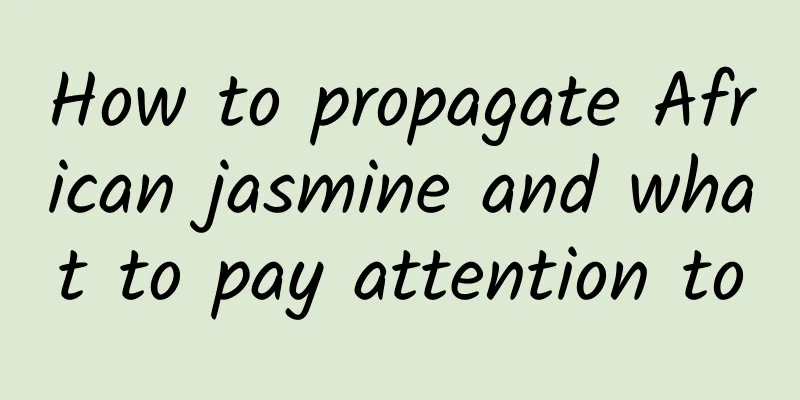How to propagate African jasmine and what to pay attention to

African jasmine reproduction methodThere are four main ways to propagate African jasmine: cuttings, division, sowing and layering. Its seeds can also be propagated, and its natural reproduction method is also seed propagation. Generally speaking, African jasmine is propagated fastest by cuttings. African jasmine breeding timeThe specific time for the reproduction of African jasmine to achieve a high survival rate depends on the method of reproduction. For example, if it is division reproduction, it is suitable to be carried out in March and April in spring, and if it is cutting reproduction, it is best to be carried out in June and July, with a high survival rate. African Jasmine Propagation MethodPropagation of African jasmine by divisionRemove the African jasmine from the pot, remove some of the soil on the roots, and then use a sharp knife to cut the weak points of the plant's roots. Each clump should have at least 2-3 stems and a part of the root system that is intact, and then plant them in pots separately. African jasmine cutting propagationCut 1-2 year old healthy African jasmine branches as cuttings. The cuttings should be 12-15 cm long, with 2 to 3 and a half leaves. The lower incision should be located 0.2-0.3 cm below the node. Plant them in peat soil, then cover the plants with plastic film to keep them moist. When the weather is clear, pay attention to proper shade. They will take root in 1-2 months. African jasmine seed propagationFirst, germinate the seeds of African jasmine, then sow them directly on loose and fertile sandy loam, cover them with a thickness of 2-3 cm, and cover them with a layer of plastic wrap to keep warm to promote germination as soon as possible. African Jasmine Breeding Tips1. Division propagation is a relatively simple method of propagation for African jasmine. However, during the division process, try to avoid too many wounds on the root system to avoid affecting future growth. 2. If African jasmine is sown and propagated in late autumn and early winter, it will generally take until the spring of the following year for seedlings to emerge. After emergence, remove the plastic wrap in time, and pay attention to strengthening water and fertilizer management, and pay attention to timely shading after summer. |
<<: Preparation and use of peanut fertilizer
>>: Preparation and use of osmanthus fertilizer
Recommend
What soil should be used for Mentiya yew
1. pH It needs slightly acidic soil, and the pH o...
Why is the Monstera leaning from side to side?
1. Not Deeply Rooted Reason: If Monstera grows cr...
What to do if the leaves of the black magic master become soft and withered
1. Waiting for adaptation Reason: If the leaves b...
Feng Shui Effects of Bamboo Cypress
Feng Shui Effect Why do we attach so much importa...
Can tiger lily be exposed to the sun?
1. Can I sunbathe? Of course, Sansevieria can be ...
Can yam be grown in the north? When to plant?
Yam, also known as yam and sand potato, is an ann...
How to maintain saffron and what to pay attention to
1. Loosen the soil Saffron likes to grow in loose...
The difference between Qianlixiang and Milan
1. Different families Thyme is slightly similar t...
When is the best time to take cuttings of cactus?
Cactus cutting time Cactus cuttings are generally...
Tips for watering and fertilizing flowers
1. Watering 1. Frequency: The frequency of wateri...
What are the breeding methods and precautions for jade dragonflies?
Jade dragonfly breeding method The jade dragonfly...
Winter maintenance of dripping Guanyin
Winter maintenance of Dripping Guanyin The Light ...
The efficacy of Platycodon grandiflorum, the efficacy of Platycodon grandiflorum soaked in water
1. Basic Introduction Platycodon, also known as &...
What are the cultivation methods and precautions of blue snowflakes?
Blue Snow Flower Introduction Blue snow flower is...
Causes and treatments for yellow leaves of gardenia
1. Excessive watering 1. Reason: Gardenia likes a...









